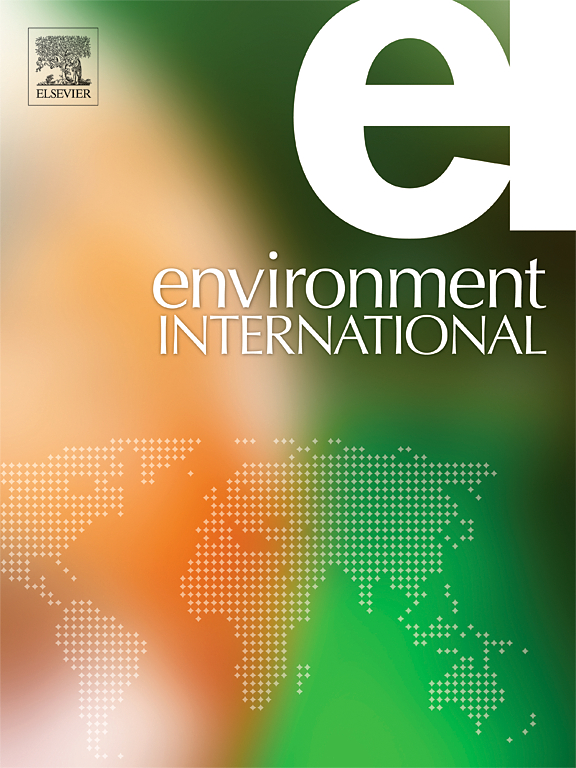Microplastics exposed by respiratory tract and exacerbation of community-acquired pneumonia: The potential influences of respiratory microbiota and inflammatory factors
IF 10.3
1区 环境科学与生态学
Q1 ENVIRONMENTAL SCIENCES
引用次数: 0
Abstract
The relationships between microplastics (MP) exposure through respiratory and exacerbation of community-acquired pneumonia (CAP), as well as the potential influences of respiratory microbiota and inflammatory factors remain unknown in adults. Therefore, we conducted a cross-sectional study involving 50 non-severe CAP (NSCAP) and severe CAP (SCAP) patients to examine the associations of MP exposure in sputum (SP) and bronchoalveolar lavage fluid (BALF) samples with SCAP risk, and the underlying influences of respiratory microbiota and inflammatory factors. The average concentration of total MP was 23.24 μg/g dw and 4.49 μg/g dw in SP and BALF samples, with the detection rates of 98 % and 94 %. Participants who performing housework often or sedentary time ≤ 5h exhibited a higher proportion of high exposure to MP. Multivariable logistic regression and weighted quantile sum regression models showed the significantly positive relationships of single type or overall MP exposure with SCAP risk. Correlation analysis revealed that MP concentrations in BALF samples were significantly associated with multiple respiratory microbiota and inflammatory factors, particularly with the reduction in α-diversity indices of the respiratory microbiota. Our findings demonstrated that respiratory exposure to MP may cause the risk increase of SCAP, along with the alterations of respiratory microbiota and inflammatory factors. It is recommended that patients with CAP should reduce the respiratory exposure to MP for preventing the exacerbation of CAP in clinical practice.


呼吸道微塑料暴露与社区获得性肺炎的加重:呼吸道微生物群和炎症因子的潜在影响
成人呼吸道接触微塑料(MP)与社区获得性肺炎(CAP)恶化之间的关系,以及呼吸道微生物群和炎症因子的潜在影响尚不清楚。因此,我们对50名非严重CAP (NSCAP)和严重CAP (SCAP)患者进行了一项横断面研究,以检查痰(SP)和支气管肺泡灌洗液(BALF)样本中MP暴露与SCAP风险的关系,以及呼吸道微生物群和炎症因子的潜在影响。SP和BALF样品中总MP的平均浓度分别为23.24 和4.49 μg/g dw,检出率分别为98 %和94 %。经常做家务或久坐时间 ≤ 5h的参与者表现出较高的MP高暴露比例。多变量logistic回归和加权分位数和回归模型显示,单一类型或整体MP暴露与SCAP风险呈显著正相关。相关分析显示,BALF样品中MP浓度与多种呼吸微生物群和炎症因子显著相关,特别是与呼吸微生物群α-多样性指数的降低相关。我们的研究结果表明,呼吸暴露于MP可能会导致SCAP的风险增加,同时呼吸微生物群和炎症因子也会发生改变。在临床实践中,建议CAP患者减少MP的呼吸暴露,以防止CAP的恶化。
本文章由计算机程序翻译,如有差异,请以英文原文为准。
求助全文
约1分钟内获得全文
求助全文
来源期刊

Environment International
环境科学-环境科学
CiteScore
21.90
自引率
3.40%
发文量
734
审稿时长
2.8 months
期刊介绍:
Environmental Health publishes manuscripts focusing on critical aspects of environmental and occupational medicine, including studies in toxicology and epidemiology, to illuminate the human health implications of exposure to environmental hazards. The journal adopts an open-access model and practices open peer review.
It caters to scientists and practitioners across all environmental science domains, directly or indirectly impacting human health and well-being. With a commitment to enhancing the prevention of environmentally-related health risks, Environmental Health serves as a public health journal for the community and scientists engaged in matters of public health significance concerning the environment.
 求助内容:
求助内容: 应助结果提醒方式:
应助结果提醒方式:


